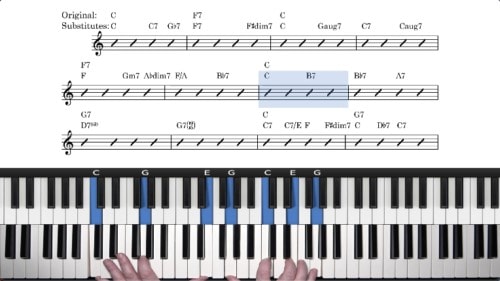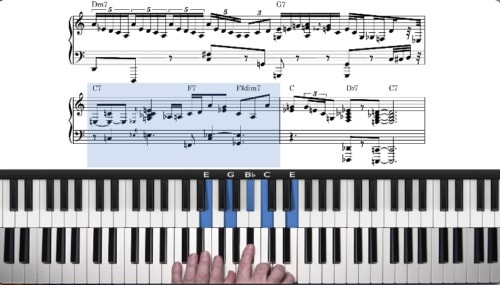Chromatic Lines & Motifs
In this lesson we explore 2 chromatic lines that work beautifully over the 6 chord in the 3625 progressions. This concept follows on from targeting the single alterations that we covered in the previous lesson.
We can voice the melody in octaves which adds impact and emphasis to this technique. We can also fill in the chord tones between the octave melody for a ‘meatier sound’ – similar to our lesson on chord melodies in the harmony module.
Chromatic Line From The b9
The first chromatic line can be used when targeting the b9 on the 6 chord, which is the C7 chord in bars 5 and 8. We play a C7 shell in our left hand and target the b9 in our right hand melody. The chromatic line starts on the b9 and then falls down chromatically to the major 7 and back up to the b9.
We can also create more impact over the C7 by adding the 3rd and #5 in between the b9 octave. This voice leads beautifully to the 7 and 9 of F7 where all notes in the right hand fall by half a step.
Chromatic Line From The #5
We then explore another chromatic line that we can play after targeting the #5 of the C7 chord. This chromatic line targets the #5, 5, & #11 over the C7 and we resolve into 9 of F7 which is a lovely colour tone to target to finish the line.
Add Both Chromatic Lines Together
The final step is to add both of these chromatic lines together – first with single note melody and next with double note melody. We can start on either the b9 or the #5 which gives us different options when improvising using this technique.
Lesson Downloads
-
Chromatic Lines & Phrases File Type: pdf
Practice Tips
-
When using this technique it's best to voice the 2 chord as a dominant chord so we play F7, and not F-7. We also add the chord tones of F7 in between the right hand octaves to thicken the sound.
-
Practice this in multiple keys and also apply it to different tunes. This chromatic sequence works great on any 3625 progression which is one of the most common progressions in jazz standards.
-
As a homework assignment, find a 3625 or 1625 progression in another tune, preferably in a different key to Eb or F which we have covered in this lesson.
-
First find the chromatic lines over the chord progression and practice this until it is comfortable so you can clearly visualise the chromatic motion. Then apply it in context of the tune.







